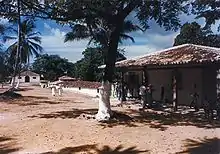Ilê Axé Opô Afonjá
Ilê Axé Opó Afonjá, also known as Centro Santa Cruz Axé of Opó Afonjá or Casa de Xangô, is a Candomblé terreiro in Salvador, Bahia, Brazil.[1]:116 It was founded by Eugênia Anna Santos (1869-1938), better known as Mãe Aninha, in 1910. The terreiro is located in the Cabula neighborhood on Rua de São Gonçalo do Retiro. Ilê Axé Opó Afonjá was the second Afro-Brazilian religious place of worship to receive heritage status from the Brazilian National Historic and Artistic Heritage Institute (IPHAN).[2][3]
| Ilê Axé Opó Afonjá | |
|---|---|
 Ilê Axé Opó Afonjá, the Casa de Xangô, Salvador, Bahia, Brazil | |
| Religion | |
| Affiliation | Candomblé |
| Sect | Ketu |
| Year consecrated | 1910 |
| Location | |
| Municipality | Salvador |
| State | Bahia |
| Country | Brazil |
 Location of Ilê Axé Opó Afonjá in Brazil | |
| Geographic coordinates | 12.997081°S 38.494881°W |
| Architecture | |
| Founder | Eugênia Ana dos Santos |
National Historic Heritage of Brazil | |
| Designated | 1998 |
| Reference no. | 1432 |
Ilê Axé Opó Afonjá was formed in 1910 by a group that separated from Ilê Axé Iyá Nassô Oká, or the Casa Branca do Engenho Velho. It is one of the primary temples of the Ketu sect of Candomblé. A terreiro of the same name was founded by Mãe Aninha in Rio de Janeiro.[1]:116
Grounds and structures
Ilê Axé Opó Afonjá covers 3.9 square kilometres (1.5 sq mi). Two-thirds of the land is covered in dense vegetation. The remainder includes religious structures, sacred plants, and a fountain dedicated to Oxum. Terreiro structures include a central temple, the Casa de Xangô, and sanctuaries dedicated to Oxalá (Obatala) and Iemanjá.
The terreiro has a public school, the Escola Eugênia Anna dos Santos, founded in 1976.[1]:103 The Ilê Ohum Lailai, also known as the Museu do Axé Opô Afonjá, is a museum founded to house physical objects related to the terreiro, including ceremonial objects, clothing, and cooking implements. It was founded in 1981. The Ikojopo Ilê Iwe Axé Opô Afonjá, also known as the Biblioteca do Axé, is a library opened by the terriro in 1996. Its collection consists of books related to African and Afro-Brazilian culture.[2][3][1]:104–105
Lineage
Ilê Axé Opó Afonjá has had five sacerdotisas, or religious leaders since 1910:
- Mãe Aninha - 1909-1938
- Mãe Bada de Oxalá - 1939-1941
- Mãe Senhora - 1942-1967
- Mãe Ondina de Oxalá - 1969-1975
- Mãe Stella de Oxóssi - 1976-[2]
Festivals
Ilê Axé Opó Afonjá holds public festivals including one dedicated to Oxóssi, held on the same day as Feast of Corpus Christi. Another is dedicated to Xangô, which begins on the evening of June 28th and June 29th. Festivals dedicated to other orixás are held on separate cycles.[3]
Heritage status
Ilê Axé Opó Afonjá received heritage status by the National Institute of Historic and Artistic Heritage (IPHAN) on July 28, 2000.[2]
References
- Santana, Marcos (2014). Mãe Stella de Oxóssi: estrela nossa, a mais singela! (in Portuguese). Salvador, Bahia, Brasil: Pimenta Malagueta Editora Editorial Aramefa. ISBN 9788565512299.
- "Terreiro Ilê Axé Opô Afonjá completa 15 anos de tombamento" (in Portuguese). Instituto do Patrimônio Histórico e Artístico Nacional. 2015-07-28. Retrieved 2016-11-06.
- Morim, Júlia (2017). "Ilê Axé Opô Afonjá". Fundação Joaquim Nabuco. Retrieved 2017-02-15.